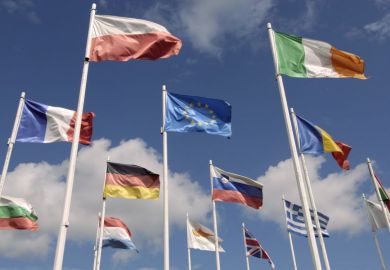Since its launch in 2000, the European Research Area (ERA) initiative has been trying to improve and link up European nations’ research systems into a “single market for knowledge, research and innovation”. It has pushed for an open labour market for researchers, gender equality and optimal circulation of knowledge, including open access. Progress has been made, but the goals are far from realised.
It is in that context that the European Union’s commissioner for innovation, research, culture, education and youth, Mariya Gabriel, last week released ambitious proposals for the ERA . Those proposals could herald transformative change for universities – and play a major role in defining the legacy of her tenure, which began last December.
The new ERA Communication goes much further than its predecessors in setting out exactly how institutions need to change to achieve a frictionless pan-national ecosystem for research and innovation – partly by defining more clearly than ever a vision for that ecosystem. Hence, as well as calling for higher rewards for collaborative activities, the communication calls for a move from a quantitative to qualitative assessment of research output.
It also demands active steps on gender equality, especially for women in more senior positions. It admonishes institutions to improve researchers’ work-life balance. It emphasises the need to recognise much more strongly public engagement, impact, open science and innovation in research careers. And it makes the case for stronger transferable skills training for all researchers to support intersectoral mobility between research and industry – posited as one way to address the precariousness of early career researchers on temporary contracts.
The commission’s ambitions on ERA are inversely proportional to its powers to enforce them. A plan for gender equality will become mandatory for Horizon Europe applicants, open science publications will be facilitated, and a toolkit will be established for strengthening careers. However, none of these in themselves will bring about transformative changes in institutional practices. Gabriel’s aspirations will only be realised if national systems and individual institutions want them to be.
It has always been difficult to hold member states to their common commitment to spending 3 per cent of national GDP on research and innovation (R&I) because the majority of such spending is committed by the private sector. However, the new ERA communication insists that within that overall target, public investment must increase from 0.81 per cent of GDP at present to 1.25 per cent.
Once again, the EU cannot compel member states to implement this policy. Nonetheless, to ensure they are globally competitive, we need a step change in public investment. And if we also want to ensure that lower-performing countries improve their participation in excellence-based funding programmes such as Horizon Europe, this cannot be done without similarly ambitious increases in public investment in those nations. If communication is the catalyst for such investment, it could be a game changer.
In addition to pursuing the ERA as a goal in itself, the EU also wants to use greater R&I collaboration to help achieve European policy objectives, such as the green deal and digital transformation. The aim will be to achieve specific outcomes through public-private partnerships and research missions, an approach that distinctly favours application-oriented research. Industrial competitiveness was always an important political frame for the necessity of ERA. But it now forms an integral part of the commission’s new communication, one of whose four goals, “fostering breakthrough research and innovation”, is, in fact, entirely about innovation. The objective of its calls for more tech scale-ups and breakthrough innovation to foster socially inclusive growth is to bring R&I priorities in close alignment with the EU’s industrial strategy.
The relaunch of the ERA is a critical opportunity for our research systems to change. But not because the EU says so. Rather, the EU has provided a new frame for sustained discussions about our future. Much of what needs to change will be difficult, and it will require new levels of funding.
Nor does the communication cover every aspect of what is needed. Remarkably, for instance, it appears to pay no attention to the fact that most of the world’s best universities are outside the EU, and that in many research fields Europe needs to find new ways to ensure that its research remains globally competitive. The document’s commitment to excellence in European R&I – including strengthening excellence in weaker systems – is essential, but does not in itself address the burning issue of how, post-Brexit, the EU can remain competitive in critical research fields such as artificial intelligence.
Moreover, for the renewed ERA to achieve the buy-in that it needs, it needs to excite researchers through its commitment to breakthrough frontier research. That will be difficult if the object of the systemic change it proposes appears to be a more effective industrial policy.
The European Council – and the wider research community – must insist on the need for world-leading research along the entire length of the research pipeline, in all areas of human knowledge, and across all of Europe. This must remain the core ambition of the ERA.
Jan Palmowski is secretary general of the Guild of European Research-intensive Universities and professor of modern history at the University of Warwick.
Register to continue
Why register?
- Registration is free and only takes a moment
- Once registered, you can read 3 articles a month
- Sign up for our newsletter
Subscribe
Or subscribe for unlimited access to:
- Unlimited access to news, views, insights & reviews
- Digital editions
- Digital access to THE’s university and college rankings analysis
Already registered or a current subscriber?








